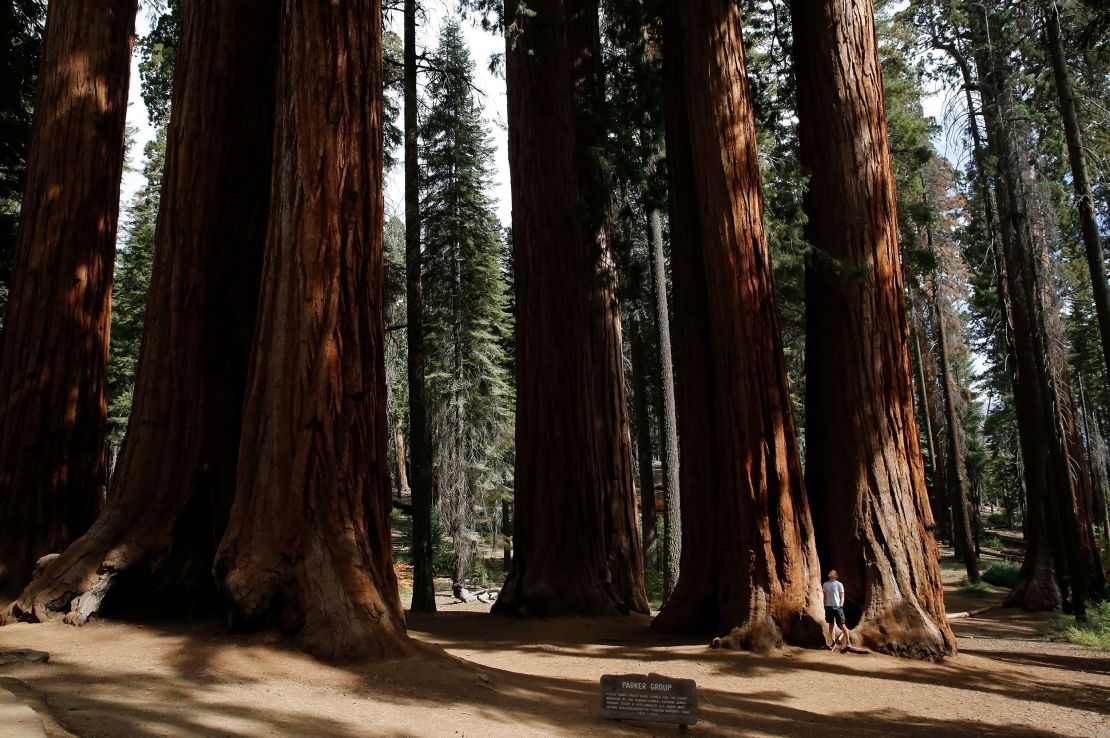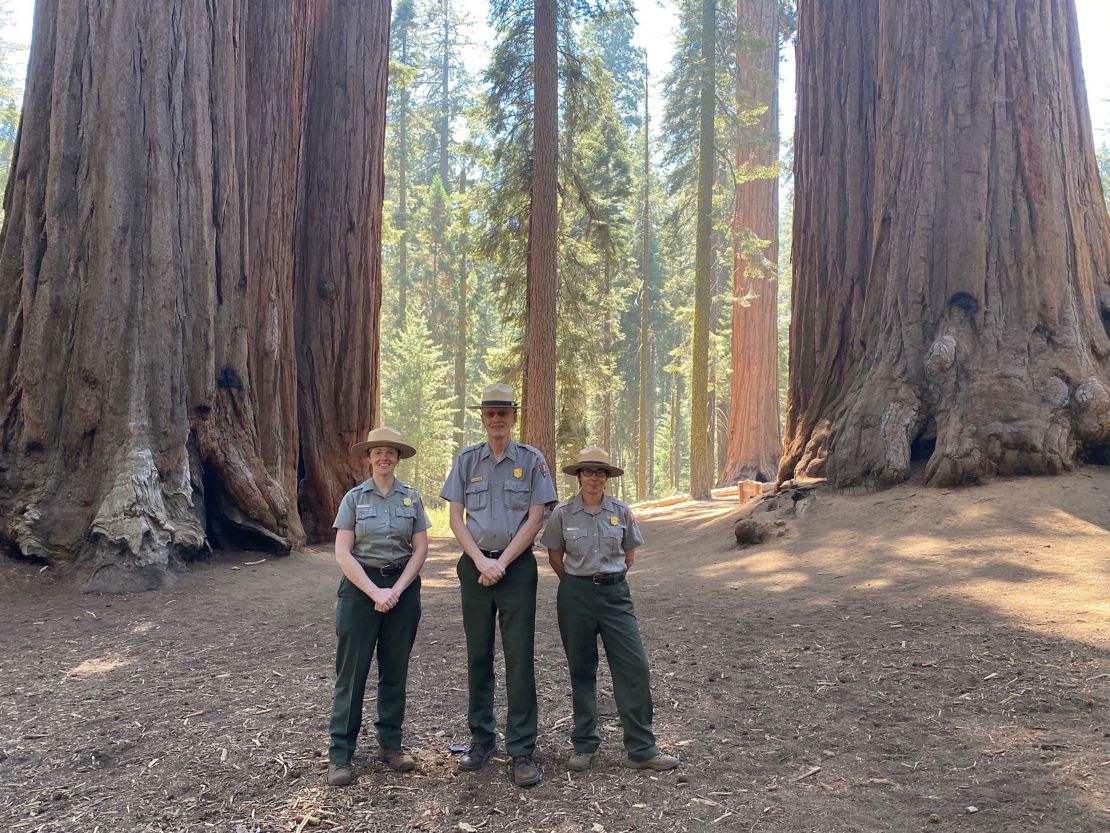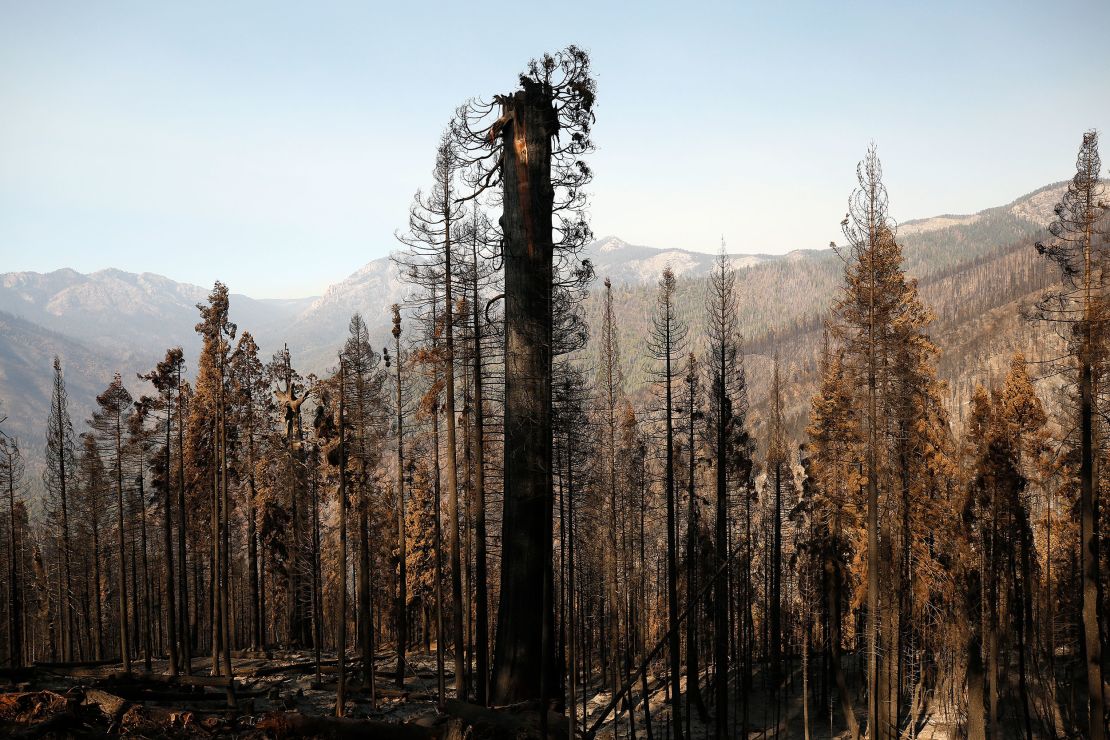Almost everything about a sequoia tree is giant: It can grow to more than 200 feet tall and live longer than 3,000 years. Yet the sequoia’s footprint is shrinking, as human-induced climate change threatens this ancient tree’s survival.
Sequoias were once found across the Northern Hemisphere, but today, they only naturally grow across the western slopes of the southern Sierra Nevada mountain range in California.
So when the Castle Fire broke out in August 2020, and merged with another fire to tear through more than 174,000 acres over four months, the loss was something even experts didn’t think possible – somewhere between 7,500 to 10,600 mature giant sequoias were destroyed, according to a report by the National Park Service, published in June.
That’s 10-14% of the entire world’s population of mature sequoias – a big chunk of history up in flames.
“They stood for a couple of thousand years before ancient Rome, before Christ,” Clay Jordan, superintendent of Sequoia & Kings Canyon National Parks, told CNN. “I mean, these trees were mature.”

There are only around 48,000 acres of sequoia groves left in the world, and the trees are now facing threats from human-made climate change in several ways.
Scientists say that climate change is making wildfires more frequent and intense. Fires in June this year in the Western states would have been “virtually impossible” without human-made climate change, according to an analysis by more than two dozen scientists at the World Weather Attribution project.
The Castle Fire last year was started by lightning, but that doesn’t mean climate change wasn’t to blame – a severe and extended drought in California had left vegetation extremely dry, turning it all into kindling, allowing fires here to burning hotter and longer.

Sam Hodder – president and chief executive officer of Save the Redwoods League, a nonprofit dedicated to protecting coastal redwoods and giant sequoias – explained that the threat is compounded by cedar bark beetles, which thrive in drier conditions.
“A giant sequoia that was weakened by drought was then subject to impacts by the bark beetle, which then further weakened the tree and made it more susceptible to mortality from fire,” he said.
Hodder described the Castle Fire as something not witnessed for hundreds, if not thousands, of years.
“This was the first time that the fire got big and hot enough to get into the crowns of multiple giant sequoia and kill them,” he said.
Sequoias have survived many a drought before, and even those that were spared from the Castle Fire are showing clear signs of stress. Christy Brigham, Sequoia & Kings Canyon National Parks’ chief of resource management and science, said the trees were shedding their needles because it’s too dry.
The trees have recovered from previous droughts, Brigham said, “but if climate change continues and droughts become more severe, they may not be able to survive.” she said.
To know what these trees have survived, researchers turn to dendrochronology, the science of studying tree rings, which Clay Jordan refers to as the sequoias’ “journals.”
Biologists can look at those rings and work out when it might have been affected by fire or periods of drought. They sometimes shed light on how humans have threatened them.
“We know that, on average, a healthy forest would experience lightning strike fires about every 10 to 20 years and those fires would be low in intensity and would help burn up those excessive fuels – keep the forest at a thin enough level so that the forest could thrive,” Jordan said.
A raft of suppression measures that authorities have undertaken to reduce forest fires has in some cases made matters worse. Forests naturally need to burn to some degree, just typically at lower intensity than they do now. Those less powerful fires burn off just enough kindling to make forests less susceptible to more intense fires.
“Now those fires burn hot enough that they can get above the thick barks and into the crowns of these giant sequoias, where they are vulnerable,” Jordan said, noting that fires are now burning at much higher intensities than they historically did.
‘Burned up toothpicks’
When Brigham and her colleagues visited the site of the Castle Fire after it stopped, they discovered a scene of such lifelessness that she described it as a “moonscape.”
“There were no seedlings. There were no needles. There were hardly any cones. Everything had been incinerated – the entire canopies. It was a field of the world’s largest burned up toothpicks,” she said.

A couple of hours away by car stands Alder Creek Grove – roughly 540 acres purchased by Save the Redwoods League at the end of 2019. On the day CNN visited, the sky was smoky and white, as yet another wildfire burned in the region. Among the charred and misshapen trees, some of the once-commanding giant sequoias had been reduced to short and spindly spires.
“Standing here, we’ve got at least a dozen dead giant sequoias. These trees were 1,500 to 3,000 years old,” said Tim Borden, Save the Redwoods League’s sequoia restoration and stewardship manager. “Their tree mortality rate for these trees annually was less than .01% and so in one year, in 2020, for us to see 10 to 14% of the total of giant sequoias alive killed in one year, in one fire? There’s nothing to compare that to.”

But patched between the peaks and valleys in the Sierra Nevada mountains, there are little saplings of hope. Down the ridge near where the monarch sequoias – which are the older trees – burned out, in an area where the fire wasn’t so intense, a carpet of new life has taken root.
That’s because after lower-intensity fires, sequoias can open up their cones and start to germinate, Hodder explained.
And there is hope, too, that people will value these trees – and all of the planet’s biodiversity – enough to influence their governments to take bolder action on the climate crisis behind the sequoias’ struggles.

During CNN’s visit to the Sequoia National Park, schoolchildren and families flocked to up the winding road to see the world’s largest tree, by volume. The General Sherman tree is stunning, a glorious monarch sequoia standing more than 275 feet tall and 36 feet wide. It’s more than 2,300 years old.
Without an urgent response to the climate crisis and an improvement in forest maintenance, this tree, which has lived through the rise and fall of entire civilizations, could be lost in a single fire, like thousands of others in this forest were.
“They’re among the most rare, the oldest, the biggest living species in the world,” Hodder said.
“We don’t have a moment to lose in getting these forests ready for our new reality.”

